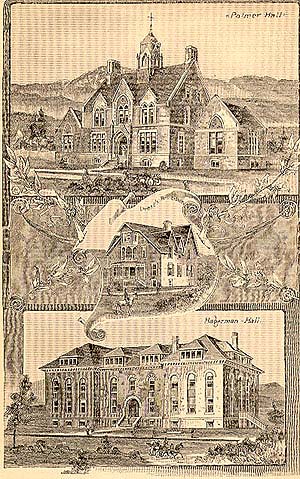Early Curriculum

Early students of the college studied plane and spherical trigonometry as well as advanced algebra which included logarithms, the binomial theorem, other infinite series, and solutions of numerical equations of any degree. Analytic geometry and the beginnings of calculus followed. In the 1889 bulletin of the college (frontispiece shown above right), mathematics for the first time is described as a coherent course of study. For a more detailed account of the curriculum development see Evolution of the Mathematics Curriculum.
Indicative of the period is the 1896 college bulletin which was the first to fully list the courses offered in Mathematics and Astronomy:
- Plane Trigonometry - The functions of one and two angles; the solution of triangles; simple applications.
- Solid Geometry - Planes and Lines in Space; Polyhedra; the Cylinder, Cone and Sphere.
- Spherical Trigonometry - With simple applications.
- Algebra - Series; the Binomial Theorem; Exponential and Logarithmic Series; Numerical Equations of any Degree.
- Analytical Geometry (Elementary) - Plane Loci of First and Second Order.
- Analytical Geometry (Continued) - More thorough study of plane loci, with the elements of the tridimensional geometry.
- Calculus, Differential and Integral
- Projective Geometry - (Cremona's treatise)
- History of Mathematics - (Cajori's text-book.)
- Higher Algebra and Higher Plane Curves - (Selections from Salmon's works.)
- Theory of Substitutions - (From Netto.)
- Astronomy (Elementary) - The descriptive rather than the mathematical side of astronomy is emphasized, and the work conducted chiefly in the form of recitations from a text-book.
- Astronomy (Observations and Computations) - The student is expected to make free use of the telescope.
- Mathematical Astronomy - Planetary Orbits, etc.
The course on the Theory of Substitutions deserves further note. Dr. Eugen Netto of the University of Giessen wrote The Theory of Substitutions and its Applications to Algebra in 1882. It was translated into English by Dr. F.N.Cole in 1892. The subject involves studying functions of n variables by observing which "substitutions" (or permutations) of the variables leave the value of the function fixed. The set of such substitutions forms a group. The study connects facts about groups with facts about the corresponding functions and leads naturally to Galois theory. The appearance of such a course so early on indicates that the department (Cajori and Loud) wished to introduce students to the latest mathematics.


